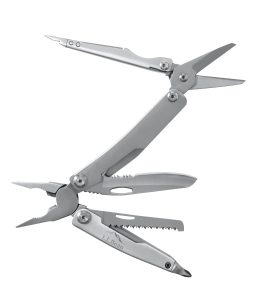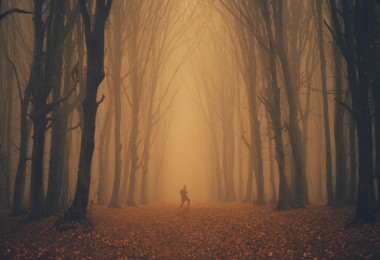Safety reminders are always important, especially as technology continues to improve. We were all novices at one time, but once you step up to backcountry terrain and long, strenuous treks you are no longer a beginner. Those amazing views and the deep, peaceful stillness of the forest are worth the effort, but be safe; your life could depend on it.

Snowshoe packages can offer snowshoes, poles, and a carrying bag for your trek: Photo courtesy of L.L Bean
DRESS FOR SUCCESS
Comfort and safety on the trail begins with a base layer that wicks moisture away from the skin, or keeps you warm when you sweat, advises Scot Balentine, Senior Equipment Product Developer at L. L. Bean. This includes liner socks under your regular ones, or a second pair for a change when on a long outing. If your feet get cold out there, changing socks can save the day.
If you need an insulating layer on top of the base, and you probably will as you begin your outing, wear a thicker layer like fleece. In some mid layers, garments feature different fabrics in specific places, such as the core, under the arms and down the sleeves, allowing moisture to escape. Polartec offers a high-pile fleece that is unbeatable for warmth, and yet packs small.
Always take a third outer layer for wind protection. Once you get chilled out in the forest, it is hard to warm up if there is any wind. Gore-Tex is still a good bet, as it is both wind and waterproof and breathes, often vented under the arms. L.L. Bean incorporated stretch into their Proshell fabrics a few years back and other outdoor wear companies offer similar products for that outer layer.
PROTECTING YOUR EXTREMITIES
Take the time to fit your boot correctly. Toes should wiggle easily, but your feet should not slide around, or be compressed from side to side. Once the boot is selected you can choose the correct socks and buy at least two pairs, so you have an extra to take along in case of wet or cold feet.
Today’s technology offers superior products that wick away moisture and usually keep the feet warm with one layer. L.L. Bean’s Cresta Wool Hiking socks of merino wool, or other socks that combine merino and Primaloft fibers are good choices. Nike also carries a sock called Dry-Fit.
To keep your hands warm, carry extra gloves or mittens, urges Balentine. If you need extra protection against the cold, try those shakable warmers that give off heat for several hours. Keeping your hands and feet warm needs to be a priority, as cold or blistered feet could mean the end of the trail for you. Your hands need to be able to grip the poles; if they turn into blocks of ice that won’t be happening.
Hypothermia can sneak up on you if it gets cold and ice crystals form under your skin, warns the American College of Sports Medicine (ACSM). Watch for intense shivering, followed by clumsiness and slurred speech.
And don’t forget your head! You can lose significant heat through the top of your head, so either wear your hat or take it along. Some people perspire more than others and that includes the head. You might need a change along the way.
HYDRATION ALONG THE TRAIL
Most people don’t think much about this when outdoors in winter, but the body cannot regulate hydration as well in cold weather. According to the American College of Sports Medicine (ACSM), close to 95% of hypothermia cases result when people are not sufficiently hydrated before going out; make it a priority to drink water before setting out.
You could become dehydrated without realizing it, since you lose water not only while perspiring, but also when you exhale. “Unless you are just doing a short loop around your local park, take along some water in a freeze-resistant container,” says Balentine. On a long outing, take some water-purification tablets along in case you need to re-hydrate from a stream or lake.
IN CASE YOU GET LOST
No one thinks it will happen to them. Plan your route ahead of time and let someone know where you are going and when you expect to be back. The first thing to do when you think you are lost is to stop and don’t panic! Include GPS on your cell phone so you can locate your position relative to the closest highway, town or ranger station. Never forget to take along a map in case your device has no reception.
This is when your compass is critical, whether on your phone or a separate device. Not much good, though, if you don’t know how to use it! Visit www.compassdude.com before your next outing for a refresher. If you don’t have a head lamp with you, remember that your cell phone may have that function.
If you are carrying a cell phone, program in the local search and rescue phone number for the area you will be in, suggests Balentine. If you retain cell reception this one precaution could save you a night in the woods.
Lastly, if you are caught out there in the great beyond with nothing more than a compass, a bit of knowledge about celestial navigation could get you on the track back to civilization. Learn how to find the Big Dipper (looks like a huge frying pan overhead) and Cassiopeia (that w-shaped constellation on its side). Then you can locate Polaris (the North Star), which is the only star that does not move locations. Both the Big Dipper and Cassiopeia constellations will help you locate Polaris. A straight line from the furthermost stars in the head of the Big Dipper should extend perpendicular to the tail and point directly to the North Star. Cassiopeia also points to the North Star, from the other side of it, so that the North Star is about equal distance between the two constellations.
And if you do get lost and have to spend an unexpected night in the backcountry, have a bright-colored bivvy bag with you for basic shelter. You could use your multi-tool to cut branches for shelter or to burn or build a snow shelter for spending the night. For more on how to build a snow shelter, check out The Snowshoe and Quinzhee Experience.
You’ll also need to eat, so bring along your knife or multi-tool to skin game. Knowledge of edible plants is essential if you are lost for an extended period of time.
FIRST AID BASICS
Here is Balentine’s list of essentials to carry when going out into the woods on snowshoes.
-
Trail map – You could be in an area with no cell phone reception
-
Compass – Know how to use it, whether a separate item or on your cell phone
-
Cell phone – Keep it in an inner pocket so batteries hold a charge
-
Water and snacks – Truly lost? It could be a while before you get out
-
Whistle – Companions nearby? This little tool could save you a night outdoors
-
Small first aid kit – Band-aid strips in case a tree limb slaps you in the face
-
Head lamp – You won’t get far in the deep darkness of the woods at night without one
-
Matches – Start a fire for warmth
-
Multi tool – Cut a few branches for fire or shelter
-
Extra layers – Obvious!
-
Glasses, hat with a visor, sun block – for those brilliant days on the trail
-
Duct tape – for repair of snowshoes or boots
-
Extra set of ski pole baskets
-
Gaiters – for deep snow, keeps snow out of footwear.
For more information about safety techniques, check out the Snowshoe Mag articles:
Book Review: Outdoor Safety and Survival
Snowshoe Education 112: Safety First
Snowshoeing, Snow Camping and Snowstorms
Play Safe In The Woods
Emergency Tips From Snowshoer Stranded for 30 Hours in Central Washington
HAPPY TRAILS!
For access to other articles by Sherry Hanson, visit www.sherryhanson.com
SOURCES:
-
Balentine Scot, L.L. Bean, Senior Equipment Product Developer. Contact person is Mary Rose MacKinnon, mmackinnon@llbean.com
- www.trails.com – helpful for basic celestial navigation










Leave a Comment